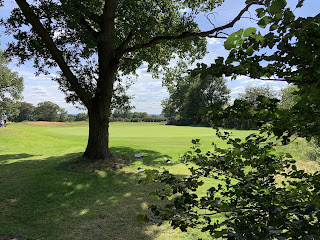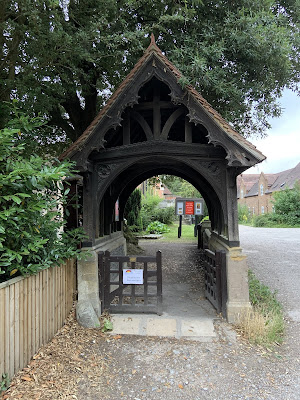The weekend before last I decided to finish off following the Hogsmill to its source. My reader may remember that I'd previously followed the river as far as I could from where it flows into the Thames at Kingston to Elmbridge Meadow
https://horseandmusketgaming.blogspot.com/2020/07/more-watery-adventures.html and from Elmbridge Meadow to Old Malden
(see second half of post here), passing along the way the coronation stone of the first kings of all England and a rather nice war memorial.
The latest river walk retraced my steps from Elmbridge Meadow to the river's source at Ewell in Surrey. A distance of about five miles, not including the extra mile or so walk to the Hogsmill from home. The first section was thus a quick march up to and beyond the A3 and up to Old Malden.
In the meadow before Old Malden I saw this chap, who flew off before I could get a good shot.
 |
Presumably a sign of a healthy river
|
 |
Note, the Hogsmill is one of 200 chalk streams in the world. I don't know who goes around checking these things.
|
I took a slightly different route from the previous occasion and veered off to the SW rather than SE and picked up the B284 out of Old Malden further along from the church. My pace slowed and I made frequent stops to looks around and take the odd photo. Along this slightly different route there's the site of a rather famous piece of art history.
 |
The same spot today. Well not today, actually 9 days ago. Or more if you're reading this after 28/7/2020.
|
Apart from odd spots like the site of the Ophelia painting, it's difficult to get right to the river's edge due to undergrowth. Given the mention of Long Meadows allowing animals to drink in the streams, I'd imagine the undergrowth was less dense in Ye Olden Days than it is now. The banks seem quite steep, and above 2 metres in many places. The terrain is quite hilly, so the banks may be naturally high in parts, though there are sections where the hand of man is in evidence.
 |
The actual stream is way down there!
|
The footpath follows the road for a few hundred meters before I could pick it up again. I encountered signs of the former industry of the river mentioned previously. Mostly the stream does not look powerful enough to power an electric toothbrush, but it must have been more vigorous, and deeper, in the past.
 |
The Powder referred to was indeed gunpowder, produced hereabouts up to and including the American Civil War. There are quite a few newish residential buildings along this stretch, or in the course of construction, no doubt marketing on the fact there's a river at the bottom of the garden.
|
 |
Sadly there's more evidence of the imbecilic suburban mind at work on this information board.
|
I picked up the riverside stream, crossing to the north bank as the stream turned west, and followed it to the A240 (Kingston Road). So no sooner had I passed the noisy Surbiton Raceway (go-kart track), I met the noisy rumble of dual-carriageway.
The next stretch from the Chessington side of the A240 was rather dull. The river ran through parkland, but it was like any suburban park with short grass. Pleasant enough but not particularly photogenic. At least it was away from the road. It began to get more interesting as I got close to Ewell.
 |
| Packhorse Bridge. 18th century or possibly earlier. Very narrow - no space to pass someone coming the other way. This is a side branch, off to the west of the Hogsmill north of Ewell. |
Further along on the main stream the scenery opens up a bit, although stretches of the river are full of reeds. It's definitely prettier around here, closer to Ewell.
One of my favourite sections came next where the river goes under the railway line from London to Epsom. The footpath follows the stream through a culvert/tunnel under the railway which surmounts an embankment. What made it more enticing to me was the fact the path is on a raised platform over the stream.
 |
Duck!
|
 |
Out the other side. After the Stygian darkness you emerge into verdant meadows and re-birth. How's that for a bit of arty-fartiness?
|
It becomes a little harder to determine which is the main stream, there seem to be branches all over the place, possibly fed by different springs. There are also what appear to be ponds, but perhaps the stream is just sluggish. Some lucky people have quaint-looking houses which back onto the water (or maybe not so lucky if it floods). I was tempted to capture the scene but it seemed intrusive so I left it and walked on.
 |
Near the end now
|
One final bit of parkland led me to what I presumed was the source. There's an ornamental pond with a fountain, and in a walled surround there's a narrow stream which comes out of a culvert.
Ah yes! This must be it.
Having checked that I had 20-odd minutes to wait for a bus I nipped into the Source for what I hoped would be some refreshment. Sadly it's 'restaurantified' and the bar had no real ale so I didn't linger longer than it took to make use of the hand gel.
So I've done it now. From Thames to source. Not exactly Henry Morgan Stanley I admit. It's not the prettiest, most bucolic river that I've ever walked along, but it's here and it does have its diversions. There's certainly a lot of history along the Hogsmill's short 6 mile length. The walk gave me a better feel for the terrain hereabouts too, and enabled me to connect the dots a little better than driving ever would. As a wargamer, there are, naturally, scenarios milling around the back of my mind. Of that, more anon.
Onto the Beverley Brook. I think.


















































